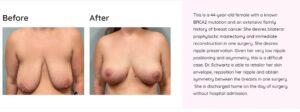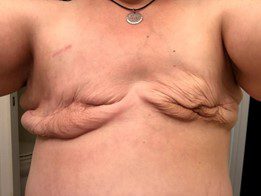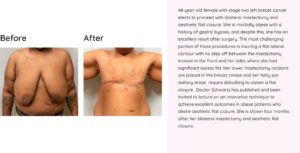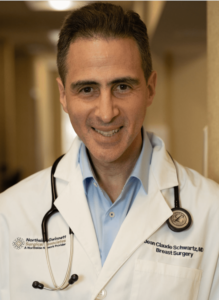Fax: 770-339-9804
Lawrenceville, Georgia 30046

Receiving a breast cancer diagnosis is understandably frightening and emotional. In that turmoil of processing such major health news, confronting mastectomy as the necessary treatment route can feel additionally distressing.
You desperately want the cancer removed as promptly and completely as possible. However, it’s difficult not to obsess over how mastectomy will impact your body image and sense of self. You ask yourself: What will I look like after surgery? How will I feel about my appearance? What options really exist?
In those worrying moments, focusing first and foremost on your full recovery should be priority number one. But it’s also important to start learning about the post-mastectomy options available so you can determine the best one aligned with both your medical and personal needs.
For some, restoring natural contours through breast reconstruction brings peace of mind. Implant or flap options aim to replace the lost breast(s), allowing for the familiar pre-surgery appearance. Then there’s another procedure called Aesthetic Flat Closure (AFC) performed post-mastectomy.
Aesthetic flat closure is a surgical procedure that is performed after either a unilateral or bilateral mastectomy. This procedure removes all breast tissue and reshapes the chest wall for a seamless, natural-looking flat chest wall contour, rather than attempting to reconstruct breasts. It’s a departure from your natural womanly curves, making it a difficult choice for many, but one that comes with significant advantages.
With aesthetic flat closure, the surgeon aims to create a natural-looking chest in a single surgery. While many procedures demand multiple follow-ups and often come with complications and discomfort, aesthetic flat closure is one of the few options that can be done with just one procedure and minimal risk of complications, easy recovery, and progression to cancer treatment.
When you hear the words “post-mastectomy”, you probably think of reconstruction next. Of course, it’s been the traditional go-to for preserving the pre-cancer body shape.
Reconstruction with either breast implants or flap procedures, however, is neither risk-free nor a perfect solution and it is important to weigh the potential risks and downsides.
Implant reconstruction can provide a natural look and feel, but there are long-term concerns.  Over time implants can become infected, and they can develop excessive scar tissue around them (capsular contracture) causing pain and deformity. Implants can also rupture or leak requiring additional surgery for correction. Some implants can even cause a rare lymphoma, breast implant-associated anaplastic large cell lymphoma (BIA-ALCL). There has also been recent discussion regarding a possible association between implants and:
Over time implants can become infected, and they can develop excessive scar tissue around them (capsular contracture) causing pain and deformity. Implants can also rupture or leak requiring additional surgery for correction. Some implants can even cause a rare lymphoma, breast implant-associated anaplastic large cell lymphoma (BIA-ALCL). There has also been recent discussion regarding a possible association between implants and:
On the other hand, autologous flap procedures utilize your own body tissues like fat and skin to reshape your breasts.
While this eliminates the risks associated with implants, it typically involves:
Then you have the long recovery journey and the accompanying discomfort, need for pain management, and possible healing issues…
Although many women request breast reconstruction, there is an increasing number of women who when confronted with the need for mastectomy choose not to pursue breast reconstruction with either an implant or their own tissues.
Considering all the above and their own beliefs and preferences, more and more women are asking for aesthetic flat closure.
All women undergoing mastectomy without reconstruction should undergo aesthetic flat closure.
The basic principles in a normal-sized patient include complete removal of the breast crease, aggressive removal of excess skin, and skillful reshaping and contouring of the tissue above and below the mastectomy incision, leaving behind a smooth and gentle profile.
aggressive removal of excess skin, and skillful reshaping and contouring of the tissue above and below the mastectomy incision, leaving behind a smooth and gentle profile.
In obese patients, aesthetic flat closure becomes more complex, and additional strategies are necessary to address the excess tissues on the sides and between the breasts. This requires additional time in the operating room which many surgeons are unwilling to invest.
Unlike reconstruction, aesthetic flat closure only requires one surgery at the time of mastectomy and there are no added risks of discomfort, complication or need for repeat operations from implants or donor tissue harvest sites. The recovery period mirrors that of a standard mastectomy procedure without reconstruction. Patients are often able to return to most normal activities within 2-4 weeks following surgery. Minor wound openings or areas of delayed healing are uncommon but can occasionally occur and typically resolve within several weeks with wound care.
Unfortunately, you might meet resistance when stating your preference for aesthetic flat closure. Many breast and plastic surgeons may challenge your request for flat closure as they are unfamiliar with the basic principles that are required to perform this procedure as breast reconstruction continues to gain momentum in the United States.
In recent years, some surgeons have begun using the term “flat denial” to describe cases where surgeons purposely leave excess breast tissue and skin after mastectomy in order to make future reconstruction easier if the patient later changes her mind.
This directly contradicts the goals of aesthetic flat closure. Leaving excess tissue destroys the aesthetic intent of the procedure and results in deformity, asymmetry, and discomfort. In hopes the patient pursues reconstruction, the surgeon directly overrides their request for flat closure.
In my opinion, although this is certainly prevalent, far  more prevalent is a surgeon’s inability to perform or unfamiliarity with this procedure. Many experienced breast surgeons must refer their patients to plastic surgeons for this type of closure who are often similarly unfamiliar with these techniques. This leaves many women with poor results.
more prevalent is a surgeon’s inability to perform or unfamiliarity with this procedure. Many experienced breast surgeons must refer their patients to plastic surgeons for this type of closure who are often similarly unfamiliar with these techniques. This leaves many women with poor results.
Picture credit: https://notputtingonashirt.org/
Women must stand up for what they want and challenge their surgeons to perform the surgeries they have asked for. Women must be proactive about searching for a surgeon who is competent at performing the true aesthetic flat closure technique.
The unfortunate truth is that many breast surgeons and even plastic surgeons who regularly perform mastectomy and reconstruction are not competent or well-versed in the intricate techniques required to properly perform aesthetic flat closure surgery.
It is absolutely essential for patients who desire a flat closure to thoroughly research candidates and find a surgeon dedicated to and experienced in providing optimal aesthetic results. Be wary of surgeons who attempt to dissuade you from flat closure or say they will “try their best”.
Knowledge, skill, and experience are crucial to achieving the best results with this technique. It’s not merely about the procedure, as the best results come from understanding the unique contouring of every patient.
Aesthetic flat closure procedure only requires one surgery at the time of the mastectomy. In 2022, just over a year ago, a well-known plastic surgeon published a nice summary of the basic principles of aesthetic flat closure noting that many surgeons were unaware or unfamiliar with this technique. While this was a nice summary, it did not really address the additional complexities encountered when performing this procedure in an overweight patient. Our group published a paper in 2023 with an associated video on how this surgery is performed in these more complicated patients.
principles of aesthetic flat closure noting that many surgeons were unaware or unfamiliar with this technique. While this was a nice summary, it did not really address the additional complexities encountered when performing this procedure in an overweight patient. Our group published a paper in 2023 with an associated video on how this surgery is performed in these more complicated patients.
Women choose aesthetic flat closure after mastectomy for a multitude of deeply personal reasons. Unlike breast reconstruction, aesthetic flat closure honors a woman’s desire to live freely without reconstructed breasts after breast cancer treatment.
Women who choose aesthetic flat closure are overwhelmingly satisfied with both their cosmetic results and their decision to forgo reconstruction. Their chests appear proportional and balanced.
Without the weight of reconstructed breasts, most women report feeling freer and more comfortable physically and emotionally. With an aesthetic flat closure, women do not need to be fitted for or wear a bra again. They have successfully closed the chapter on their breast cancer diagnosis and feel able to fully move forward with their lives.
Only you can decide what feels most appropriate for your body and spirit as you navigate life after breast cancer. The choice between aesthetic flat closure, breast reconstruction, or delayed reconstruction is incredibly nuanced and personal.
Take time to thoroughly research your options, get educated, and make lists of pros and cons. Seek input from loved ones, but remember their wishes do not supersede your own. Find a surgeon who will listen compassionately and present options clearly without pressuring or shaming you.
While others may offer opinions on what they would do in your situation, no one else can truly know what feels right for you. Your values, lifestyle, priorities, and personal style should guide your choice above all else.
You may encounter some who view flat closure as extreme or assume all women desire reconstruction. But choosing flat closure is not anti-feminine or vain. It is an act of love toward your body during immense vulnerability.
This article was originally written for: notputtingonashirt.com
Jean-Claude Schwartz, MD, PhD – Breast Cancer and Reconstructive Surgeon
 Dr. Schwartz is a highly respected national leader in oncoplastic breast surgery. He is a preferred provider for the majority of insurance plans and is highly recommended by insurance companies and patients alike. By performing most of his surgeries in an outpatient ambulatory center, he saves his patients on hospital costs, co-pays, and more.
Dr. Schwartz is a highly respected national leader in oncoplastic breast surgery. He is a preferred provider for the majority of insurance plans and is highly recommended by insurance companies and patients alike. By performing most of his surgeries in an outpatient ambulatory center, he saves his patients on hospital costs, co-pays, and more.
As a breast surgeon and reconstructive surgeon, he performs most mastectomies and reconstructions in one surgery, saving his patients time and money by seeing only one expert, paying only one set of deductibles and co-pays, and most importantly, reducing time spent in the operating room while providing unparalleled results.
Dr. Schwartz and his entire staff specialize in breast surgeries, and as such, are highly experienced in dealing with insurance companies. They can provide guidance and invaluable information to women undergoing breast reconstructive surgeries. Additionally, as part of the Northside Hospital system, patients benefit beyond Dr. Schwartz’s practice.
Dr. Schwartz is always accepting new patients diagnosed with breast cancer and makes it his priority to see them immediately, despite his very busy schedule.
Click to SCHEDULE YOUR CONSULTATION TODAY!

